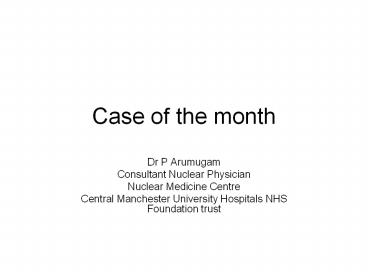Case of the month - PowerPoint PPT Presentation
1 / 14
Title:
Case of the month
Description:
Case of the month Dr P Arumugam Consultant Nuclear Physician Nuclear Medicine Centre Central Manchester University Hospitals NHS Foundation trust – PowerPoint PPT presentation
Number of Views:62
Avg rating:3.0/5.0
Title: Case of the month
1
Case of the month
- Dr P Arumugam
- Consultant Nuclear Physician
- Nuclear Medicine Centre
- Central Manchester University Hospitals NHS
Foundation trust
2
History
- 58 year old Female.
- Atypical chest pain.
- Status -post PCI mid LAD November 2009.LMS 50
lesion negative on IVUS. Equivocal DSE due to
LBBB.
3
Stress /Imaging protocol
- Adenosine stress protocol (140mcg/kg/min over 4.5
minutes) without exercise due to LBBB. No
ischaemic symptoms reported. Maximal HR 101. - 2 day rest/stress with Tc- Myoview 640 MBq for
stress and rest (as per BMI) - Stress and rest images were acquired on GE
Millennium Hawkeye 4 camera ( 120 minutes post
stress due to extra cardiac activity and 70
minutes after rest injection). - Images were reconstructed iteratively.
- Images were considered to be of good quality with
no significant attenuation or scatter artefact.
4
(No Transcript)
5
(No Transcript)
6
- Q What is your interpretation of the perfusion
study? - A
- Apparent (visual) stress induced cavity dilation.
- Moderate Anteroseptal reduction in perfusion post
stress which completely normalises at rest ( 3
/20 segments).
7
Gated study screen capture
8
- Q- What is your interpretation of the single
frame captured gated study ? - A-
- There appears to be reduced anterior and apical
wall motion post stress (images acquired 120
minutes post) with normal appearance at rest
myocardial stunning. - There is a significant difference between post
stress and resting ejection fraction, again
consistent with prolonged post ischaemic stunning.
9
- Q What is your interpretation based on perfusion
and wall motion assessment? - A Presence of reversible perfusion abnormality,
reversible wall motion abnormality and drop in
systolic function post stress suggests
angiographically significant disease in the LAD.
10
Angiographic findings
- Patient underwent a repeat angiogram 1 month post
SPECT study - Reported to show proximal LAD stenosis but patent
mid LAD stent. - No significant LCx, RCA or LM stenosis.
- MDT case discussed and being considered for
single vessel CABG.
11
Teaching points
- Assessment of both perfusion and function
provides additional information. - Regional wall motion abnormality post stress in
ischaemic segments has been described with
exercise1,2 myocardial imaging due to stunning. - True ischaemia is rare with vasodilator stress as
it induces flow heterogeneity and hence wall
motion abnormality is not expected with adenosine
/ dipyridamole. Steal phenomenon through
collaterals is a rare exception.
12
- In a recent publication 3 however, 1/3rd of
patients had post vasodilator stress wall motion
abnormalities which was proportional to the
amount of ischaemia. - In this patient, there is evidence of regional
wall motion abnormality, elevated ESV and drop in
ejection fraction post stress all consistent
with ischaemia induced LV dysfunction. - This may be related to critical narrowing of the
coronary artery involved 2 and may also be an
indicator of multi vessel disease 4.
13
- SPECT images are acquired 45 60 minutes post
stress and do not reflect a true peak stress
ejection fraction nor regional wall motion and in
theory ,a resting one. Hence some clinicians do
not feel the need to perform 2 gated studies
(i.e. at rest and post stress). - However demonstration of wall motion abnormality
several minutes post stress would be consistent
with post ischemic stunning. - As post stress gated information can be obtained
without any additional radiation nor significant
impact on throughput, it is useful to obtain this
data .
14
References
- Louise Emmett et al. Reversible regional wall
motion abnormalities on exercise
technetium-99mgated cardiac single photon
emission computed tomography predict high-grade
angiographic stenoses . J Am Coll Cardiol, 2002
39991-998 - Sharir T, Bacher-Stier C, Dhar S, et al.
Identification of severe and extensive coronary
artery disease by postexercise regional wall
motion abnormalities in Tc-99m sestamibi gated
single photon emission computed tomography. Am J
Cardiol 2000861171-5. - Druz et al. Postischemic stunning after
adenosine vasodilator stress. Journal of Nuclear
Cardiology 535 Volume 11, Number 5534-41 - Lima RS, Watson DD, Goode AR, et al. Incremental
value of combined perfusion and function over
perfusion alone by gated SPECT myocardial
perfusion imaging for detection of severe
three-vessel coronary artery disease. J Am Coll
Cardiol 20034264-70.

